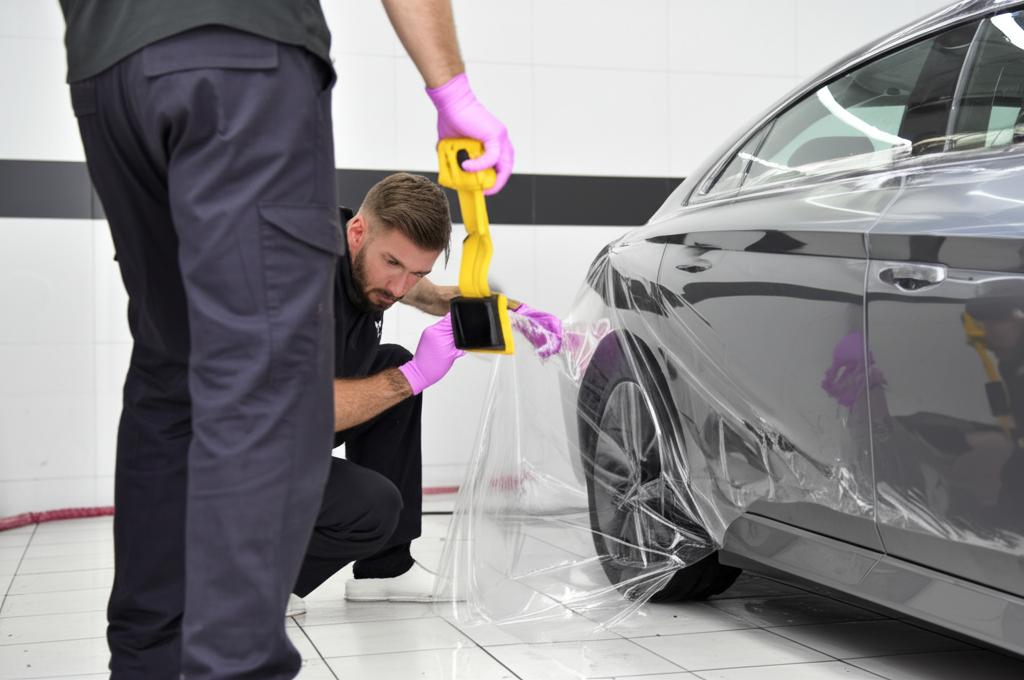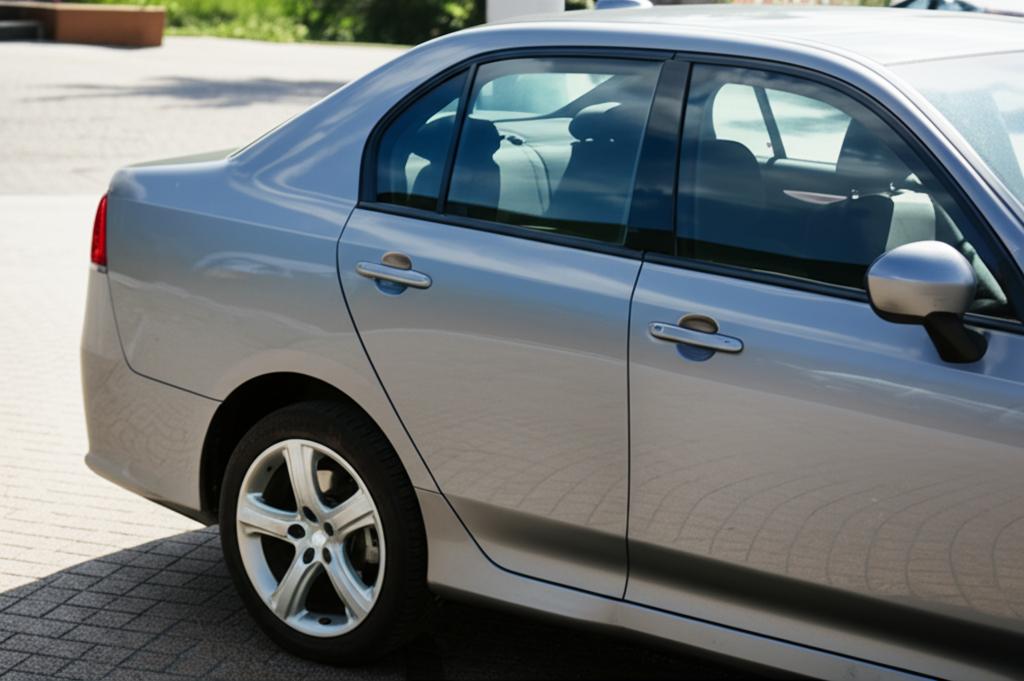Congratulations on your new car and your exciting plans to explore the beautiful landscapes of Thailand! As you settle in and prepare for those memorable self-driving adventures, from the bustling streets of Bangkok to the serene beaches of the South or the misty mountains of the North, you’ve made a significant investment. Your car is not just transportation; it’s your key to freedom and exploration in your new home. But have you thought about how you’ll protect its pristine paintwork from the unique challenges of the Thai environment, especially during the notorious rainy season?
Thailand’s tropical climate, while beautiful, can be tough on vehicles. The intense sun can fade paint over time, and the heavy downpours of the rainy season bring not just water, but also road grime, debris, and sometimes even small stones kicked up by other vehicles. Add to this the occasional bird droppings, tree sap, or accidental scratches from tight parking spots, and your car’s paint faces a constant barrage of threats. Leaving your car exposed means risking chips, scratches, and dulling that can significantly reduce its appearance and resale value. So, how can you ensure your beloved vehicle stays looking brand new, ready for every road trip, come rain or shine?

We recently had a client, Mr. Li, who moved to Bangkok from Shanghai. He bought a stunning new SUV, dreaming of weekend getaways to Khao Yai and Hua Hin. Initially, he relied on regular washing and waxing, but after just a few months, he noticed small chips on the hood and front bumper, likely from highway driving. The constant battle against water spots after rain and the worry every time he parked near trees or faced traffic spraying up debris started to dampen his enthusiasm for driving.
Mr. Li came to us looking for a more robust solution. We introduced him to the concept of Paint Protection Film (PPF), specifically high-quality Thermoplastic Polyurethane (TPU) film. We explained how this invisible layer acts as a shield, absorbing impacts and protecting the original paint underneath. After seeing samples and understanding the process, he decided to get a full front-end protection package, covering the hood, fenders, bumper, and side mirrors.
The installation process was meticulous. Our skilled technicians thoroughly cleaned and prepped the surfaces. Then, using custom-cut patterns for his specific SUV model, they carefully applied the transparent TPU film, ensuring perfect alignment and no bubbles or creases. The film is virtually invisible once applied, preserving the car’s original color and finish.

The change for Mr. Li was remarkable. He no longer winces at the sound of gravel on the road or rushes to wash off bird droppings. The TPU film has self-healing properties, meaning minor scratches disappear with heat. Water beads off easily, making cleaning much simpler, especially after driving through rain. He now enjoys his road trips with complete peace of mind, knowing his car’s paint is protected by a durable, invisible barrier. His SUV still looks as flawless as the day he bought it, despite navigating Thailand’s diverse driving conditions.
Understanding Your Options: Why TPU Film Stands Out
When it comes to protecting your car’s paint, you have several options, each with different levels of protection, durability, and cost. Let’s compare TPU film with some common alternatives:
| Feature | TPU Paint Protection Film (PPF) | Ceramic Coating | Waxing/Sealants | Standard Vinyl Wrap (Color Change) |
|---|---|---|---|---|
| Primary Function | Physical barrier against chips, scratches, abrasions, stains, UV damage, environmental contaminants. | Chemical bond creating a hydrophobic layer, UV protection, enhanced gloss, minor scratch resistance. | Temporary protective layer, enhanced gloss, water beading. | Color change, aesthetic customization, minor abrasion protection (less than TPU). |
| Protection Level | Excellent – Strong physical barrier against impacts (stone chips), deep scratches, scuffs, and environmental damage. Self-healing properties for minor scratches. | Good – Protects against UV fading, chemical stains, and makes cleaning easier. Provides some resistance to light swirling but not significant impact protection. | Basic – Provides a sacrificial layer against light contaminants and UV, but wears off quickly and offers no impact protection. | Moderate – Protects against light scratches and abrasions, but not designed to absorb significant impacts like stone chips. |
| Material | Thermoplastic Polyurethane (TPU) – A high-performance, elastic polymer known for durability, flexibility, and self-healing. | Liquid polymer (SiO2, TiO2) that cures into a hard, glass-like layer. | Natural (Carnauba) or synthetic waxes/polymers. | Polyvinyl Chloride (PVC) or similar plastics. |
| Lifespan | Long (5-10+ years) – Durable and designed for long-term protection. | Medium (2-5 years) – Lifespan varies based on quality and maintenance. | Short (Weeks to Months) – Requires frequent reapplication. | Medium (3-7 years) – Lifespan depends on material quality and exposure. |
| Appearance Change | Virtually Invisible. Available in clear gloss, clear matte, or sometimes subtle tints. Preserves original paint color and finish, often enhancing gloss. | Adds significant gloss and depth to the paint. | Adds temporary gloss and slickness. | Completely changes the vehicle’s color. Can be gloss, matte, satin, or textured. |
| Maintenance | Easy to clean. Regular washing. Specific PPF cleaners recommended but not always necessary. | Easy to clean (hydrophobic). Requires pH-neutral soaps. Avoid abrasive chemicals. | Requires frequent washing and reapplication. | Easy to clean. Avoid harsh chemicals or abrasive washing. |
| Cost (Initial) | Highest – Due to material cost, technology, and professional installation. | Medium to High – Cost varies based on coating quality and preparation required. | Lowest – DIY options are very inexpensive. Professional application is also relatively low cost. | High – Cost varies based on material and coverage (full car is expensive). |
| Suitable For | Owners who want the best possible physical protection against damage, preserving resale value, especially for new or high-value vehicles and those driven frequently in challenging conditions. | Owners who want enhanced gloss, UV protection, and easier cleaning, with some resistance to light scratches. Often applied over PPF for added hydrophobicity and gloss. | Owners seeking basic, temporary protection and enhanced gloss with minimal investment. | Owners primarily looking to change the vehicle’s color or add graphics. Offers some protection but not the primary benefit. |
As you can see, for comprehensive protection against the physical hazards of driving in Thailand – stone chips, scratches from tight spots, and the abrasive elements that come with heavy rain – TPU Paint Protection Film is unmatched. Its durability and self-healing properties mean your car stays protected year after year, making it a wise long-term investment, especially if you plan on keeping your car for several years or want to maintain its value for future resale.
What Our Clients Say
We’ve helped many car owners in Thailand protect their vehicles with TPU film. Here’s what a few have shared:
“Moving to Thailand, I was worried about keeping my new car perfect. The rain here is intense, and I saw how quickly other cars got marked up. Getting the TPU film done was the best decision. My car looks as good as new, and I don’t stress about driving on different roads anymore. It’s peace of mind on wheels!” – David C., Pattaya
“I love driving my car on weekend trips, but the thought of stone chips on the highway always bothered me. After getting the front of my car protected with TPU, that worry is gone. Cleaning is also so much easier after a rainy drive. Highly recommend it for anyone driving in Thailand.” – Anya S., Chiang Mai
“I wasn’t sure if it was worth the cost, but seeing how well the TPU film has protected my car through one rainy season and countless trips, I can say it absolutely is. It’s an invisible shield that works. My car’s paint is still flawless.” – Wei L., Bangkok
Ready to Protect Your Investment?
Don’t let the challenges of the road in Thailand diminish the joy of owning and driving your car. Investing in high-quality TPU Paint Protection Film is investing in the longevity and appearance of your vehicle, ensuring it stays beautiful and protected for all your adventures. Whether you’re navigating city traffic or exploring the open road, drive with confidence knowing your paintwork is shielded by the best.
Choosing the right film and ensuring professional installation is crucial for optimal results. Our team specializes in expert TPU film application, using premium materials designed to withstand the Thai climate. We can assess your needs and recommend the best coverage options for your vehicle and driving habits.
📱 Want to learn more about car wrap & paint protection?
Feel free to reach us on LINE:

🌐 Official Website: https://tpuwraps.com
Frequently Asked Questions about TPU Film
- Q: What exactly is TPU film?
- A: TPU stands for Thermoplastic Polyurethane. It’s a high-performance, elastic polymer material used to create Paint Protection Film (PPF). It’s known for its durability, flexibility, impact resistance, clarity, and self-healing properties.
- Q: How does TPU film protect my car’s paint?
- A: TPU film creates a durable, transparent barrier over your car’s paint. This layer absorbs the impact from stone chips, prevents scratches from keys or minor abrasions, protects against environmental contaminants like bird droppings and tree sap, and blocks harmful UV rays that can cause fading. Its self-healing property means light scratches on the film’s surface disappear when exposed to heat.
- Q: Will TPU film change the appearance of my car’s paint?
- A: High-quality TPU film is virtually invisible once installed correctly. It is optically clear and designed to preserve your car’s original color and finish. In fact, it often enhances the paint’s gloss and depth.
- Q: How long does TPU film last in Thailand’s climate?
- A: With professional installation and proper care, high-quality TPU films are designed to last 5 to 10 years or even longer. They are specifically engineered to resist yellowing, cracking, and peeling, even under intense sun and heavy rain like in Thailand.
- Q: How do I clean and maintain a car with TPU film?
- A: Maintaining a car with TPU film is generally easier than without. You can wash it normally using standard car wash soap. The film’s smooth surface makes dirt and grime less likely to stick, and water beads off easily. Avoid using abrasive cleaners or harsh chemicals. Regular washing is recommended to keep the film looking its best.
- Q: Can TPU film be removed?
- A: Yes, high-quality TPU film can be safely removed by a trained professional without damaging the underlying paint, even years after installation. This is important if the film is ever damaged or when you decide to sell the vehicle.
Protecting your vehicle’s paintwork is an essential step in maintaining its beauty and value, especially when living and driving in Thailand. Invisible TPU Paint Protection Film offers the most comprehensive defense against the elements and road hazards you’ll encounter on your journeys. Enjoy your new car and your Thai adventures to the fullest, with the confidence that your investment is well-protected.

